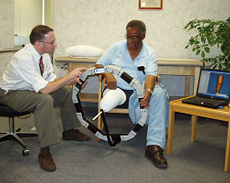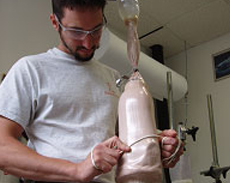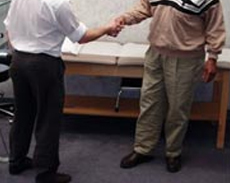Whatever your needs, working with one of our ABC Certified practitioners will assure you get the right prosthesis to help you meet your goals. Because we take a whole person approach, we also provide access to support services and resources for our patients. We recognize transitioning to the use of a prosthesis can be a physically and emotionally challenging time, and address the issues that are involved.
There is an amazing range of technology used in developing and creating a prosthesis. Based upon a wide variety of factors, one individual may have their needs met through a high tech computerized device, while another person can be fully satisfied by a simpler device. One person may engage in a wide variety of vigorous pursuits and require additional specialty prostheses, while someone else needs just one. The bottom line: each patient is unique and is treated according to their individual needs.
Creating a new prosthesis does require a number of steps, all designed to make sure you are getting the right device with the best possible fit. Below you can see the BioMetrics Process for creating a custom prosthesis.
 Step 1:
Step 1:
To allow our technicians to fabricate and assemble a custom prosthesis designed specifically to meet your requirements, you will be measured for a socket (the part of the prosthesis in contact with the residual limb). This is done by using either plaster or fiber glass casting material, or a CAD (Computer Aided Design) system.
 Step 2:
Step 2:
Once your measurements have been taken, your prosthetist will have an in-depth discussion with you about your lifestyle and physical needs. Working as a team, BioMetrics will develop a prosthesis designed to enable you to meet your needs and life goals.
 Step 3:
Step 3:
The cast created in Step 1 is filled with either medical plaster or machined with the CAD system to create a positive mold. Once the positive mold is modified (a process designed to optimize the socket fit) a diagnostic socket is fit to the patient. This socket is transparent, allowing the clinician an unobstructed view to evaluate the fit and make changes before creating the stronger and more durable definitive socket. Multiple fittings are at times necessary to assure the best possible design with a comfortable and effective fit.
 Step 4:
Step 4:
Once the temporary socket fits securely and comfortably, a thermo-plastic or laminated definitive socket is fabricated. The foot, knee (if necessary) and other components are then attached to the socket.
 Step 5:
Step 5:
If you wish, once the prosthesis is fully assembled, a cover can be shaped to match the existing limb for both shape and skin tone.
 Step 6:
Step 6:
The leg is now finished and ready for use.
You will be given a wearing schedule which will enable you to get accustomed to your prosthesis. Once proper fit and function have been established, we recommend coming in every six months so your prosthetist can evaluate your limb for fit and mechanical wear.
Our level of professionalism and passion for our work has helped us establish a loyal patient base who know they can count on us.
